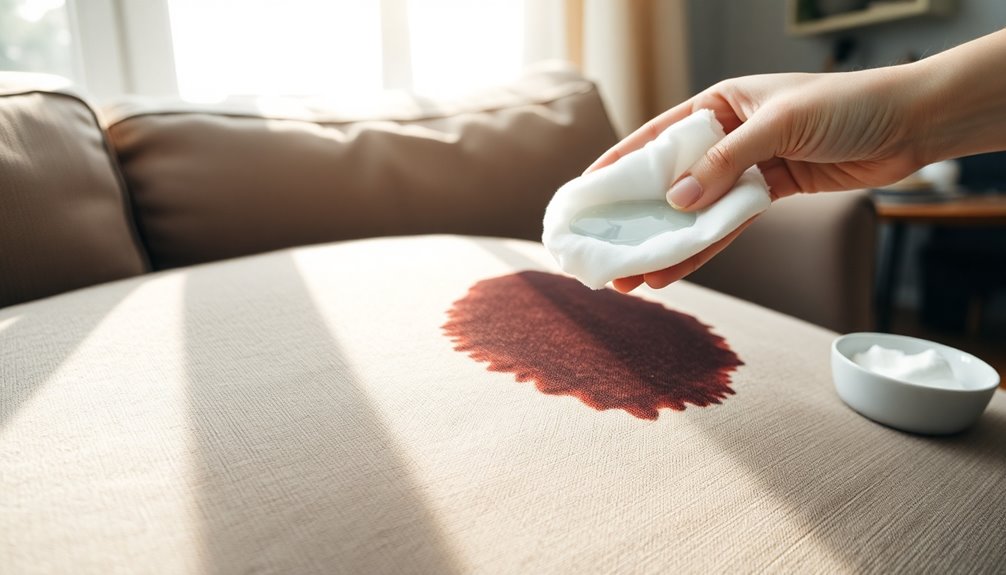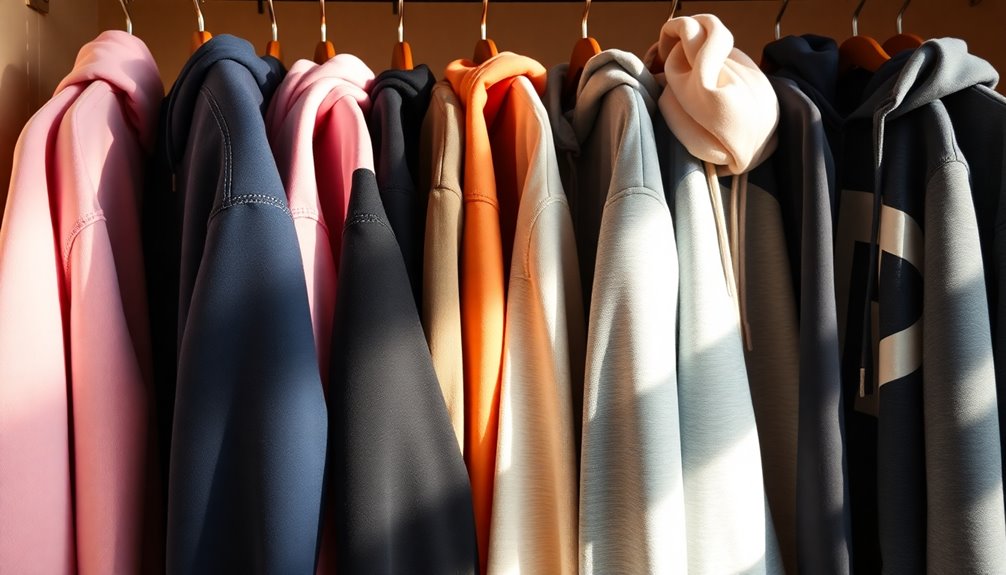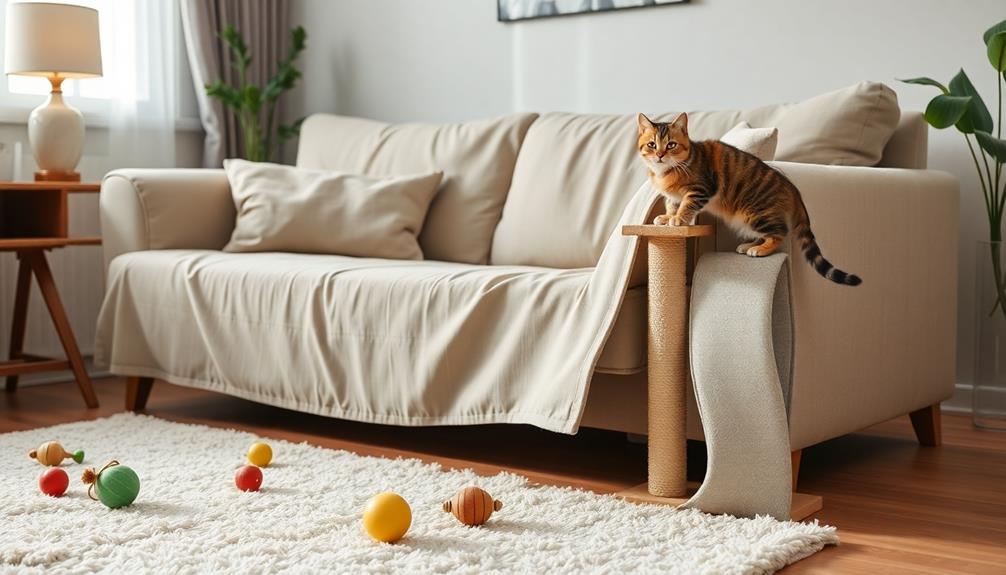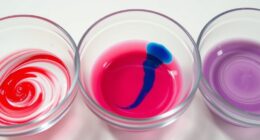To remove permanent marker from your fabric sofa, start by blotting the stain gently with a clean white cloth. Use rubbing alcohol or a mixture of dish soap and vinegar, applying it lightly to the mark. Blot every few minutes to lift the ink, being careful not to rub, as this can spread the stain. Rinse the area with cold water after treatment to eliminate any residue. If the stain persists or you’re dealing with delicate fabrics, consider consulting a professional. There’s more to learn about specific methods tailored to various fabric types that can help restore your sofa. Additionally, for tougher stains, you might want to explore specialized cleaners designed for upholstery. It’s essential to always test any solution on an inconspicuous area first to ensure it won’t damage the fabric. For those seeking comprehensive guidance, numerous resources detail how to remove ink stains from upholstery, allowing you to effectively tackle even the most stubborn marks.
Key Takeaways
- Blot the ink stain gently with a clean, white cloth to absorb excess marker without spreading it further.
- Apply rubbing alcohol to a cotton ball and dab it on the stain, avoiding saturation of the fabric.
- Rinse the treated area with cold water to remove any residue from the rubbing alcohol.
- Test a small, hidden area of the fabric first to check for color change before applying any cleaning solution.
- If the stain persists, consider consulting a professional cleaner for effective removal without damaging the fabric.
Introduction
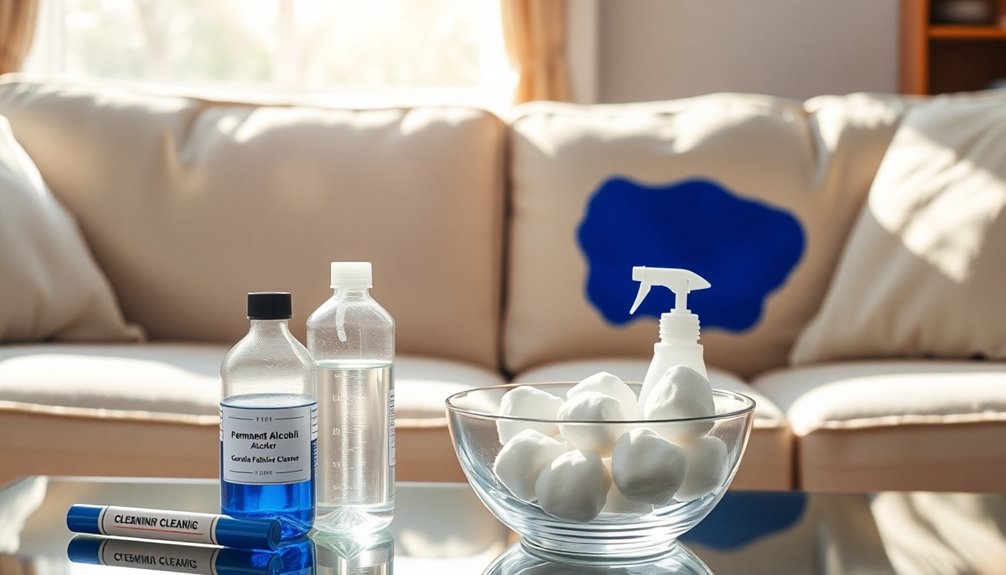
If you've got kids or pets, you know how easily permanent marker stains can happen on your fabric sofa. Routine spot checks and fabric-specific cleaning techniques can help you tackle not just ink stains, but also food spills. Let's explore effective methods to keep your sofa looking fresh and clean.
Routine Spot Checks
Regularly checking your fabric sofa for stains is essential in maintaining its appearance and longevity. Incorporating routine spot checks into your cleaning schedule can help you catch any issues, like permanent marker marks, before they set in. Aim to perform these checks at least once a week, especially if you have children or frequently use markers.
When conducting your inspections, use a clean, white cloth to avoid transferring any colors onto your sofa. If you spot a stain, don't panic. Having a designated cleaning solution, such as a vinegar and dish soap mixture, ready will allow you to respond quickly.
For effective stain removal, gently dab the stain with your clean cloth, applying your cleaning solution as needed. Document any stains you find and the methods you use to treat them. This log will help you track what works best for your specific upholstery type, making future cleanings more efficient. By staying proactive with routine spot checks, you'll keep your fabric sofa looking fresh and extend its lifespan, ensuring it remains a stylish and inviting part of your home.
Fabric-Specific Cleaning Techniques
When it comes to removing permanent marker from fabric sofas, knowing the specific cleaning techniques for different materials can make all the difference. For cotton upholstery, start by blotting the stain with rubbing alcohol using a clean cloth. After that, rinse the area with cold water to remove any residue. Chenille fabric can be treated similarly; apply rubbing alcohol directly to the stain and sponge the area with cold water to lift it.
If you're dealing with linen or velvet, also use rubbing alcohol, and remember to rinse afterward to prevent any residue from setting. However, with delicate suede, it's best to consult a professional cleaner to avoid damaging the fabric.
For synthetic upholstery, you can mix dish liquid and vinegar to effectively break down the ink. Apply this solution to the stain, then rinse the area with a damp cloth to ensure all cleaning agents are removed. By using these fabric-specific cleaning techniques, you can tackle permanent marker stains more effectively and keep your sofa looking its best.
Targeting Ink and Food Stains
Stains from ink and food can be a real headache, especially on fabric sofas where they seem to stand out the most. If you need to remove permanent marker or food stains, acting quickly is key. Start by blotting the stain with a clean white cloth, doing this every five minutes to absorb as much of the ink or food residue as possible without spreading it further.
Next, mix a solution of dish liquid, vinegar, and cold water. This effective blend can break down ink stains and make removal easier. Apply this mixture to the stained area, gently dabbing with a cloth. For stubborn ink stains, rubbing alcohol is your best friend. Apply it carefully from the edges of the stain towards the center to minimize fabric damage.
Avoiding Direct Sunlight Exposure
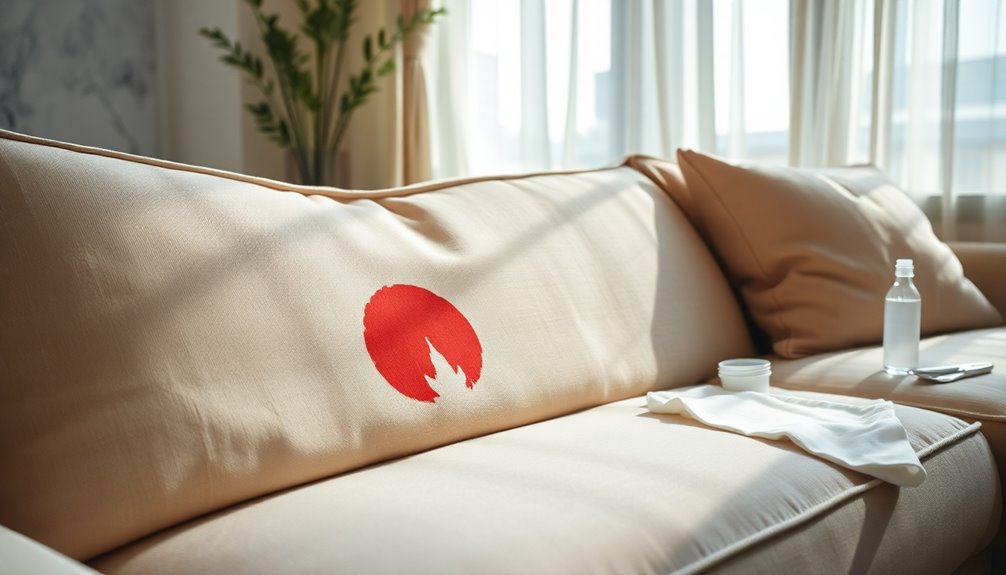
To protect your fabric sofa from permanent marker stains, avoiding direct sunlight is crucial. Consider scratch-resistant fabric options and protective layers that can shield your sofa from UV damage. Regular fabric conditioning will also help maintain its integrity, keeping it looking great for longer.
Scratch-Resistant Fabric Options
Although you might love the look of a fabric sofa, choosing the right scratch-resistant options is essential for maintaining its beauty and longevity. Fabrics like microfiber and synthetic blends are designed to withstand wear and tear while minimizing the visibility of stains, including permanent marker. Their tightly woven structure helps prevent ink absorption, making it easier for you to remove ink when accidents happen.
To keep your scratch-resistant sofa looking its best, avoiding direct sunlight exposure is crucial. Prolonged UV exposure can fade colors and weaken the fibers over time, reducing the fabric's durability. Pairing your choice of fabric with a stain-resistant finish provides an extra layer of protection against common stains. Moreover, investing in a high-efficiency model can enhance your overall home environment by supporting sustainability goals through energy-efficient technology.
Regular maintenance is also key. Vacuum your sofa frequently to remove dust and debris, and consider using fabric protectants to enhance durability. This proactive approach reduces the likelihood of stains setting in, helping you maintain your sofa's pristine condition. By selecting the right scratch-resistant options and committing to regular upkeep, you can enjoy your fabric sofa for years to come without worrying about unsightly marks.
Protective Fabric Layers
Your fabric sofa deserves protection from the harmful effects of direct sunlight, which can lead to fading and weakened fibers. By utilizing protective fabric layers, you can significantly extend the life of your upholstery. Consider adding slipcovers or using UV-blocking window treatments to shield your sofa from intense sunlight.
Many high-quality fabrics come with built-in UV resistance, which helps maintain their appearance and integrity over time. This feature is essential, as direct sunlight not only fades colors but also makes fibers more susceptible to stains, including permanent marker mishaps.
To further safeguard your upholstery, regularly rotate or rearrange your furniture. This simple practice minimizes the sun's impact on specific areas, preventing uneven fading and ensuring a more uniform look. Additionally, applying fabric protectants can create a barrier against both UV damage and stains, giving you extra peace of mind.
Regular Fabric Conditioning
Maintaining the beauty and longevity of your fabric sofa goes beyond just protecting it from sunlight; regular fabric conditioning is a key part of the care routine. Fabric conditioner can help maintain the integrity of the fibers, preventing them from becoming brittle and more susceptible to staining, especially from permanent markers. By applying fabric conditioner, you create a protective barrier that repels stains and makes it easier to wipe away accidental marks before they set.
To ensure your sofa stays in top shape, it's recommended to condition the fabric every 3 to 6 months. This routine not only enhances the appearance of your upholstery but also boosts its durability. Just remember to avoid direct sunlight exposure, as UV rays can fade colors and weaken the fibers, making them less resilient to cleaning processes.
Before applying fabric conditioner broadly, always test it on a small, inconspicuous area to ensure it doesn't alter the color or texture. By following these steps, you'll keep your fabric sofa looking fresh and vibrant while effectively preventing staining issues. Regular fabric conditioning is essential for preserving the beauty of your furniture.
Upholstery Stitching Check
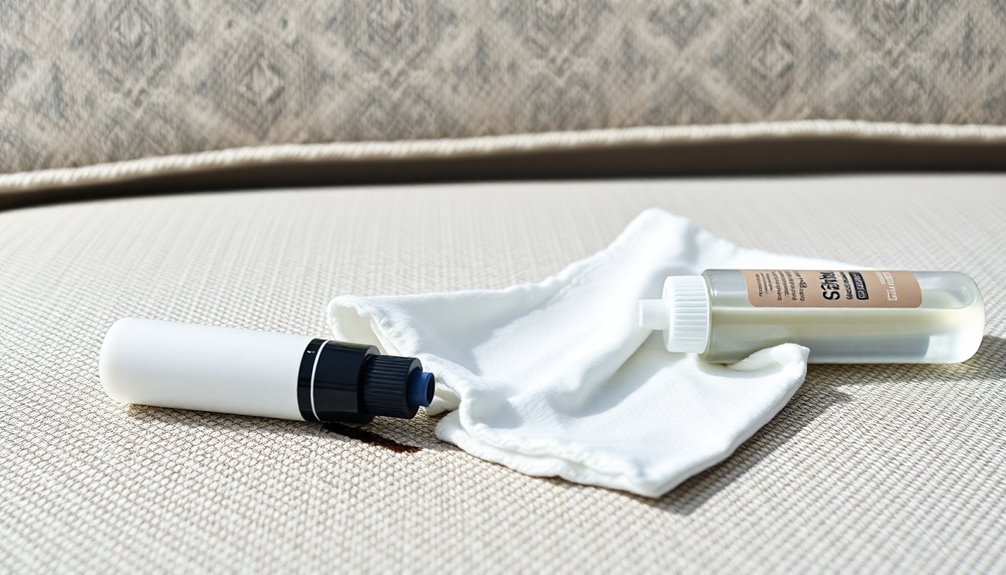
Before you tackle that permanent marker stain, check the upholstery stitching for any weaknesses. If you notice any frayed threads, it might be a sign that your fabric sofa needs reupholstering for durability. Taking care of these details ensures you maintain a cozy, inviting seating experience.
Frame Weaknesses
Inspecting the upholstery stitching on your fabric sofa is crucial for its overall durability. Regularly check for signs of fraying or loosening, as weak stitching can lead to more significant issues over time. Pay special attention to high-stress areas, like seams and corners, where wear and tear are more likely to occur.
Use a magnifying glass to spot any small tears or gaps in the stitching that might not be visible to the naked eye. Identifying these weaknesses early allows you to intervene before the damage worsens. If you find any weak spots, you can reinforce them with a needle and thread or seek help from a professional upholsterer.
Maintaining strong upholstery stitching not only enhances the longevity of your fabric sofa but also ensures it can withstand regular use without developing further issues. This is especially important if you've dealt with marker stains or other difficult-to-remove blemishes on the cloth. A sturdy frame with secure stitching will help keep your sofa looking great while you tackle any stains that arise. Additionally, regular assessments of your sofa's condition can prevent minor issues from escalating into major repairs. Remember, a well-stitched sofa is easier to clean and maintain, making your life that much simpler.
Reupholstering for Durability
Reupholstering your fabric sofa can significantly enhance its durability, especially when you pay attention to the upholstery stitching. Regularly check the stitching to ensure it remains intact; loose threads can compromise both the durability and appearance of your furniture. Inspect the seams for any signs of fraying or unraveling, as these issues can lead to further damage if not addressed promptly.
When you're reupholstering, consider using upholstery thread that matches the original fabric. This not only maintains a cohesive look but also strengthens the overall structure of your sofa. It's essential to reinforce high-stress areas, such as corners and seams, with additional stitching to boost durability. Additionally, opting for natural materials can enhance the longevity and overall aesthetic of your reupholstered piece.
If you're unsure about your stitching skills, professional reupholstering services can provide expert techniques that enhance both longevity and aesthetic quality. They know how to handle upholstery thread effectively, ensuring that your fabric sofa stands the test of time. By prioritizing these aspects of reupholstering, you'll enjoy a piece of furniture that not only looks great but is built to last.
Cozy, Inviting Seating Experience
Maintaining the comfort and appeal of your fabric sofa goes hand in hand with keeping an eye on its upholstery stitching. Regularly checking the stitching helps ensure it remains intact and secure, preventing any loose threads from leading to fabric fraying and further damage. Look closely for signs of wear or unraveling, particularly in high-traffic areas, as these can compromise the cozy seating experience you desire.
To keep your sofa looking its best, use a soft brush or a vacuum attachment to gently remove dust and debris from the stitching. This prevents buildup that could weaken the upholstery over time. Additionally, consider applying a fabric protector to shield both the stitching and fabric from stains and spills, extending your sofa's lifespan.
Don't forget to schedule periodic inspections of your sofa's stitching, especially after cleaning or heavy use. Regular dental check-ups can help catch potential issues early is key to maintaining both the structural integrity and inviting appearance of your seating. By staying proactive, you'll ensure your fabric sofa remains a cozy haven for relaxation and enjoyment.
Fabric Dye Adjustments
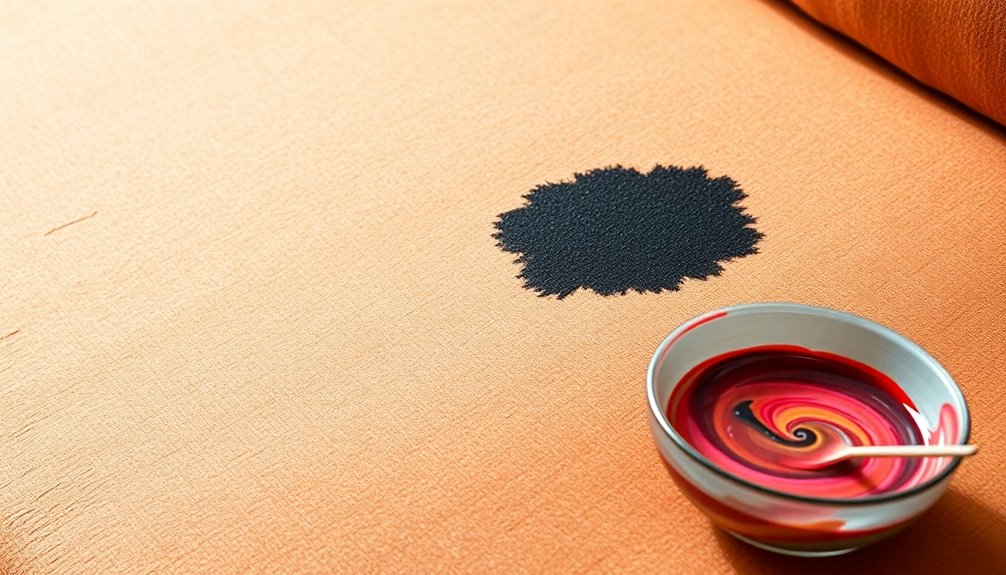
When dealing with fabric dye adjustments after attempting to remove a permanent marker from your sofa, it's essential to understand how different cleaning methods can affect the fabric's color. Certain cleaning solutions, like rubbing alcohol or vinegar, can be effective but may also lead to color changes, especially on fabrics dyed with reactive dyes. These dyes are particularly sensitive to solvents and can result in unexpected color bleeding.
Before you apply any cleaning solution, always perform a patch test on an inconspicuous area of your sofa. This will help you assess any potential color changes or damage to the dye. If you notice bleeding during the patch test, it's best to avoid that cleaning method.
Fabrics made from synthetic fibers, such as polyester, usually resist dye alterations better than natural fibers like cotton or wool. If you experience significant color changes during the cleaning process, consider reaching out to professional dye restoration services to restore the original hue of your fabric. Remember, careful application and immediate blotting are crucial to minimizing any adverse effects.
Routine Maintenance for Upholstery
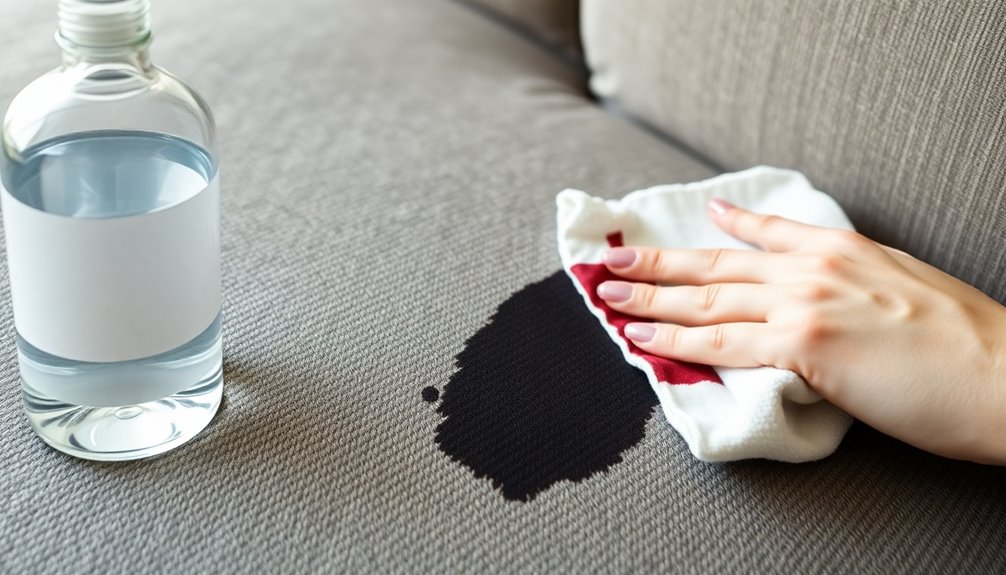
Keeping your fabric sofa in top shape goes beyond just addressing stains and marks. Routine maintenance is key to preserving the beauty and longevity of your upholstery. Start by regularly vacuuming your sofa to remove dust and debris, preventing dirt buildup and potential staining. For pet owners, using a soft brush or lint roller can help you gently lift pet hair and lint, maintaining your sofa's appearance.
It's important to periodically check the manufacturer's care instructions specific to your fabric type. Following these guidelines will help you avoid any potential damage during cleaning. Additionally, consider applying fabric protectors or sprays designed for upholstery. These products create a barrier against stains and spills, making future clean-up much easier. Regular maintenance not only enhances your sofa's appearance but also ensures optimal air quality by reducing allergens that can accumulate in upholstery.
Don't forget to schedule a deep cleaning session with a professional cleaner at least once a year. This not only extends the life of your sofa but also keeps it looking fresh and inviting. By incorporating these simple maintenance practices, you'll ensure that your fabric sofa remains a cherished part of your home for years to come.
Conclusion
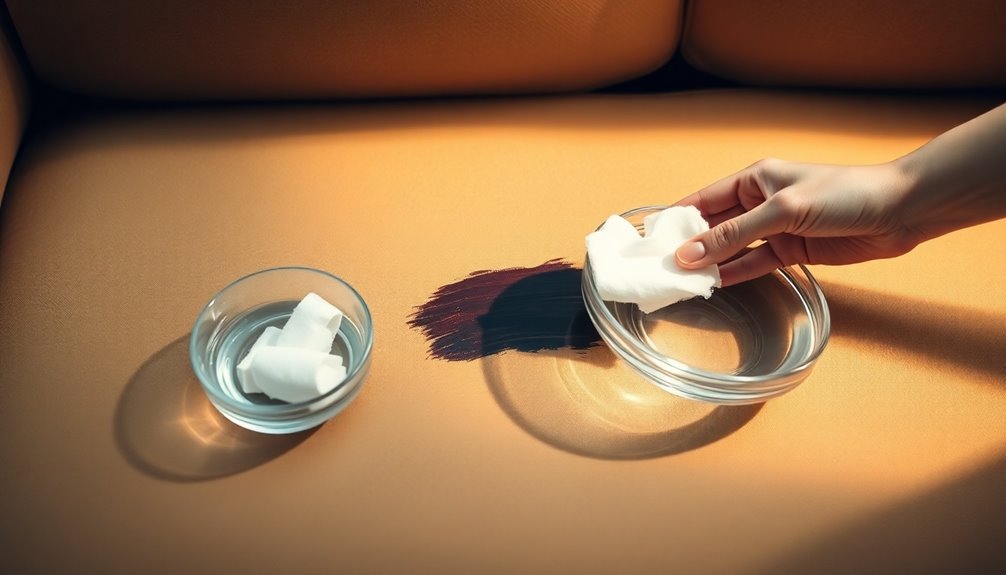
In summary, removing permanent marker from your fabric sofa doesn't have to be a daunting task. With the right cleaning solution, you can tackle those stubborn stains effectively. Start by mixing 1 tablespoon of dish liquid, 1 tablespoon of vinegar, and 2 cups of cold water to create a powerful cleaning solution. Use a damp sponge to apply it to the stained area and let it sit for 30 minutes. Blot the stain every five minutes with a dry cloth to absorb the stain and lift the ink away.
If the initial attempts don't yield the desired results, don't hesitate to repeat the process. For particularly persistent marks, dab the area with rubbing alcohol, working from the edges toward the center to prevent spreading. Afterward, rinse the affected area with a damp cloth to remove any leftover cleaning solution residue.
If you still can't get rid of the stain after trying these methods, consider consulting professional cleaning services. They have the expertise and tools to handle tough stains effectively. Remember, with a bit of patience and the right approach, your fabric sofa can look as good as new!
Frequently Asked Questions
Can You Get Permanent Marker Out of Couch Fabric?
Yes, you can often get permanent marker out of couch fabric. You'll need to act quickly to stop the ink from setting in. Start by blotting the stain with a clean cloth soaked in rubbing alcohol or a mixture of dish soap, vinegar, and water. Work from the edges in to avoid spreading. Rinse the area with a damp cloth afterward. If needed, repeat the process or try a magic eraser for better results.
How Do You Remove Dried Permanent Marker?
To remove dried permanent marker, start by applying rubbing alcohol to a clean cloth or cotton ball. Gently blot the stain, working from the edges toward the center. If the stain sticks around, mix 1 tablespoon of dish liquid and 1 tablespoon of vinegar with 2 cups of cold water. Use a damp sponge to apply it, letting it sit for 30 minutes, and blot regularly until the stain lifts. Always test first!
Will Permanent Marker Stay on Fabric?
Yes, permanent marker can stay on fabric if you don't act quickly. The ink is designed to resist water, making it tough to remove once it sets. If you leave the stain for too long, it'll bond with the fibers more firmly, increasing your chances of it becoming a lasting mark. To prevent this from happening, you should treat the stain as soon as possible to improve your chances of removal.
How to Get Permanent Marker off Cloth Seats?
To get permanent marker off cloth seats, mix 1 tablespoon of dish liquid, 1 tablespoon of vinegar, and 2 cups of cold water. Use a damp sponge to apply the solution, blotting the stain every five minutes with a clean cloth to absorb the ink. If the stain's stubborn, dab rubbing alcohol on it, working from the edges inward. Finally, use a magic eraser and a brush to restore the upholstery texture.
